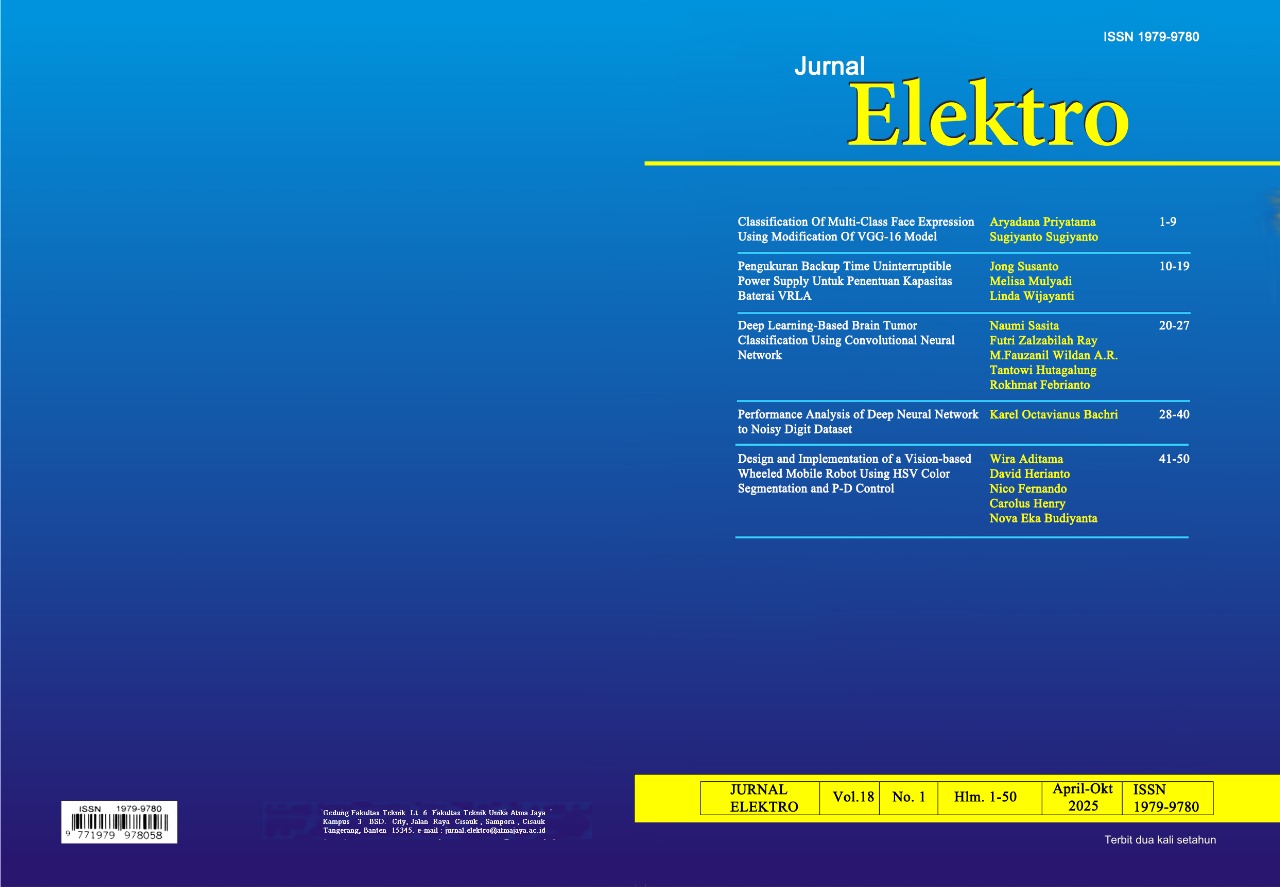Classification Of Multi-Class Face Expression Using Modification Of VGG-16 Model
DOI:
https://doi.org/10.25170/jurnalelektro.v18i1.6653Keywords:
Facial recognition, Facial expression, classification, K-Fold Cross Validation, VGG-16, GridSearchAbstract
In the era of modern technology, facial recognition has become an important application in various fields, such as security, education and health. One method used to recognize faces is a Convolutional Neural Network (CNN), specifically the VGG-16 architecture which is known for its consistent performance. But even though CNN can recognize faces, its accuracy in recognizing faces is inadequate. This research aims to increase the accuracy of facial expression classification so that it is more optimal by modifying the CNN VGG-16 architecture. This research uses GridSearch techniques, K-Fold Cross Validation, and utilizes multiple datasets. The dataset used consists of two image datasets, namely SMIC and SAMM facial-micro expressions, each of which has been normalized and converted to a grayscale scale measuring 48x48 pixels. The GridSearch process is applied to optimize parameters such as the number of filters, learning rate, dropout rate, activation function, and batch size. The K-Fold Cross Validation technique with five folds was used to ensure the generalization of the model to new data. The research results show that this modification is able to achieve validation accuracy of up to 98.31% in the training process, showing a significant improvement compared to the standard method. And showed an increase in accuracy in testing of 98.04% in research.
References
[1] E. Dalam, P. Lintas, B. Lilik, A. Budiono, and M. Masing, “INNOVATIVE: Volume 2 Nomor 1 Tahun 2022 Research & Learning in Primary Education.”
[2] P. Ekman, Universal facial expressions in emotion, vol. 8. 1973.
[3] A. L. Sigit Guntoro, E. Julianto, and D. Budiyanto, “Pengenalan Ekspresi Wajah Menggunakan Convolutional Neural Network.”
[4] K. Grm, V. Struc, A. Artiges, M. Caron, and H. K. Ekenel, “Strengths and weaknesses of deep learning models for face recognition against image degradations,” IET Biom, vol. 7, no. 1, pp. 81–89, Jan. 2018, doi: 10.1049/iet-bmt.2017.0083.
[5] K. Zheng, D. Yang, J. Liu, and J. Cui, “Recognition of teacher’s facial expression intensity based on convolutional neural network and attention mechanism,” IEEE Access, 2020, doi: 10.1109/ACCESS.2020.3046225.
[6] N. Zhou, R. Liang, and W. Shi, “A Lightweight Convolutional Neural Network for Real- Time Facial Expression Detection,” IEEE Access, vol. 9, pp. 5573–5584, 2021, doi: 10.1109/ACCESS.2020.3046715.
[1] E. Dalam, P. Lintas, B. Lilik, A. Budiono, and M. Masing, “INNOVATIVE: Volume 2 Nomor 1 Tahun
2022 Research & Learning in Primary Education.”
[2] P. Ekman, Universal facial expressions of emotion, vol. 8, California Mental Health Research Digest,
Autumn 1970.
[3] Guntoro, A. L. S., Julianto, E., & Budiyanto, D. (2022). Pengenalan ekspresi wajah menggunakan
Convolutional Neural Network. Jurnal Informatika Atma Jogja, 3(2), 155–160.
https://doi.org/10.24002/jiaj.v3i2.6790.
[4] Elsheikh, R.A., Mohamed, M.A., Abou-Taleb, A.M. et al. Improved facial emotion recognition model
based on a novel deep convolutional structure. Sci Rep 14, 29050 (2024). https://doi.org/10.1038/s41598-
024-79167-8.
[5] Kopalidis, T.; Solachidis, V.; Vretos, N.; Daras, P. Advances in Facial Expression Recognition: A Survey
of Methods, Benchmarks, Models, and Datasets. Information 2024, 15, 135.
https://doi.org/10.3390/info15030135.
[6] Muhammad Sajjad, Fath U Min Ullah, Mohib Ullah, Georgia Christodoulou, Faouzi Alaya Cheikh,
Mohammad Hijji, Khan Muhammad, Joel J.P.C. Rodrigues, A comprehensive survey on deep facial
expression recognition: challenges, applications, and future guidelines, Alexandria Engineering Journal, Volume 68, 2023, Pages 817-840, ISSN 1110-0168, https://doi.org/10.1016/j.aej.2023.01.017.
[7] K. Grm, V. Struc, A. Artiges, M. Caron, and H. K. Ekenel, “Strengths and weaknesses of deep learning
models for face recognition against image degradations,” IET Biom, vol. 7, no. 1, pp. 81–89, Jan. 2018,
doi: 10.1049/iet-bmt.2017.0083.
[8] D. -H. Lee and J. -H. Yoo, "CNN Learning Strategy for Recognizing Facial Expressions," in IEEE Access,
vol. 11, pp. 70865-70872, 2023, doi: 10.1109/ACCESS.2023.3294099.
[9] K. Zheng, D. Yang, J. Liu, and J. Cui, “Recognition of teacher’s facial expression intensity based on
convolutional neural network and attention mechanism,” IEEE Access, 2020, doi:
10.1109/ACCESS.2020.3046225.
[10] N. Zhou, R. Liang, and W. Shi, “A Lightweight Convolutional Neural Network for Real- Time Facial
Expression Detection,” IEEE Access, vol. 9, pp. 5573–5584, 2021, doi: 10.1109/ACCESS.2020.3046715.



